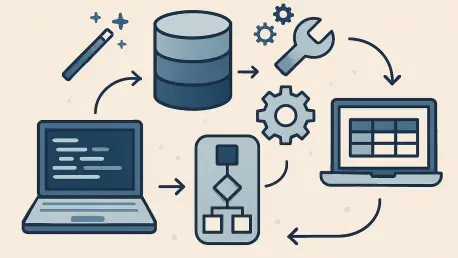Imagine a scenario where a marketing director needs urgent insights on customer behavior across multiple regions for a critical campaign launch, and instead of waiting days for a data engineer to craft complex SQL queries, the director types a simple request in plain English. Within minutes, a fully optimized query is generated, validated, and integrated into an ETL pipeline. This is not a distant dream but a reality in 2025, driven by prompt-based ETL automation. This transformative technology leverages large language models (LLMs) to convert natural language instructions into actionable data operations, streamlining workflows in modern data environments.
The inefficiencies of traditional extract, transform, load (ETL) processes have long plagued organizations striving for agility in data-driven decision-making. Prompt-based ETL automation emerges as a solution, reducing reliance on technical expertise and empowering non-technical users to engage directly with data systems. This review delves into the mechanisms, advancements, and real-world impact of this technology, assessing its potential to reshape data operations.
Core Features and Mechanisms
Natural Language as the New Interface
At the heart of prompt-based ETL automation lies the ability to articulate data needs through natural language prompts. Users, whether business analysts or product managers, can describe their requirements in plain English, bypassing the need for manual SQL coding. For instance, a prompt like “show total sales by region for the last quarter” replaces the intricate process of writing and debugging complex queries.
This declarative approach simplifies data requests, making analytics accessible to a broader audience. It eliminates the barrier of syntax knowledge, allowing focus on the intent behind the data operation rather than the technical execution. As a result, teams can iterate quickly on business questions without waiting for specialized support.
Schema Context for Precision
To ensure the generated SQL aligns with specific database structures, prompt-based systems integrate schema metadata into the process. Details such as table names, column types, and relationships are embedded to guide LLMs in crafting accurate queries. This step is crucial for tailoring outputs to particular database dialects like PostgreSQL or BigQuery.
The inclusion of such context minimizes errors in query generation by grounding the model’s understanding in the actual data environment. It ensures that the system does not produce generic or mismatched code, enhancing reliability across diverse data warehouses. This precision is a cornerstone of effective automation in complex setups.
SQL Generation Powered by Intelligence
The translation of enriched prompts into executable SQL code is handled by LLMs, which rely on advanced techniques like tokenized pattern recognition and pre-trained schema comprehension. These models interpret user intent and map it to structured query logic, producing optimized code ready for deployment. Tools like PromptQL and LangChain facilitate this process, catering to both technical and non-technical users.
This automation significantly reduces the time spent on query development, allowing teams to focus on interpreting results rather than crafting syntax. The underlying technology continuously evolves, incorporating feedback to improve accuracy and adapt to varied use cases, ensuring relevance in dynamic data landscapes.
Ensuring Quality Through Validation
Validation and optimization form a critical stage in prompt-based ETL workflows. Generated SQL undergoes rigorous checks for correctness, performance, and adherence to best practices. Techniques such as indexing recommendations and early data filtering are applied to enhance efficiency and prevent resource-intensive operations.
Automated validation mechanisms also safeguard data integrity by flagging potential issues before execution. This step mitigates risks like inefficient query patterns or unintended data modifications, maintaining trust in automated outputs. Such diligence is essential for scaling this technology in production environments.
Seamless Pipeline Integration
Once validated, the SQL is embedded into ETL pipelines using orchestration tools like dbt, Airflow, or Prefect. This integration automates the extraction, transformation, and loading of data, driven entirely by user prompts. The flexibility to connect with various data systems and expose results through APIs further enhances its utility.
This stage ensures that prompt-driven queries are not isolated outputs but part of cohesive workflows. Automation extends beyond query generation to encompass the entire data movement process, enabling organizations to operationalize insights swiftly and efficiently across platforms.
Performance and Advancements
Rapid Evolution of LLM Capabilities
The adoption of LLMs in data operations has accelerated over recent years, with significant strides in their ability to handle complex SQL generation. Research into frameworks like PromptQL demonstrates a marked reduction in analytics prototyping time, with some studies noting up to 40% faster iterations starting from 2025. This performance boost underscores the technology’s value in fast-paced environments.
Beyond speed, advancements include fine-tuning models for specific data stacks, ensuring compatibility with unique organizational needs. Emerging trends also focus on incorporating user feedback loops to refine outputs iteratively, addressing early limitations and enhancing precision in real-world deployments.
Industry-Wide Impact
Across sectors like marketing, product analytics, and customer support, prompt-based ETL automation is proving its worth. Non-technical users now explore data in systems like BigQuery without writing code, directly querying insights through intuitive interfaces. This democratization bridges communication gaps between domain experts and engineers, fostering collaboration.
Case studies reveal tangible benefits, such as enabling rapid data exploration for campaign adjustments or troubleshooting support issues in real time. The ability to align business intent with technical execution without intermediaries marks a significant shift in how data teams operate, amplifying organizational agility.
Challenges in Implementation
Accuracy and Reliability Concerns
Despite its promise, prompt-based ETL automation faces hurdles in ensuring consistent accuracy of generated SQL. Misinterpretations by LLMs can lead to incorrect queries, particularly when prompts lack clarity or schema metadata is incomplete. This dependency on input quality remains a key challenge for widespread adoption.
Efforts to improve reliability are ongoing, with developers focusing on better context handling and error detection. Until these issues are fully resolved, human oversight remains necessary to catch discrepancies, especially in critical data operations where precision is non-negotiable.
Security and Scalability Issues
Security concerns also loom large, particularly around the risk of unsafe queries that could compromise data integrity or expose sensitive information. Robust guardrails, such as SQL linters and dry runs, are essential to prevent such risks, yet they add layers of complexity to implementation.
Scalability poses another obstacle, as handling intricate transformations across massive datasets can strain current LLM capabilities. Addressing these limitations requires continuous innovation in model training and system design to support the growing demands of enterprise data environments.
Final Thoughts and Next Steps
Looking back, prompt-based ETL automation stood as a game-changer in 2025, offering a glimpse into a future where data operations were no longer bound by technical barriers. Its ability to empower diverse user groups and streamline workflows left an indelible mark on how organizations approached analytics and decision-making.
Moving forward, the focus should shift toward enhancing model accuracy through advanced context awareness and integrating stricter data governance frameworks to bolster security. Exploring deeper compatibility with evolving data systems will also be crucial. As these improvements unfold, stakeholders must prioritize robust validation mechanisms and user training to maximize the technology’s potential, ensuring it becomes a cornerstone of agile, inclusive data strategies.









